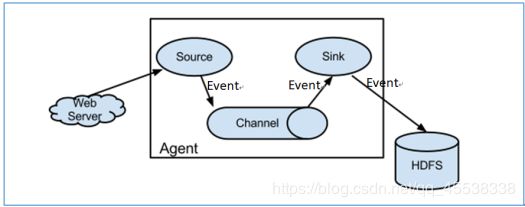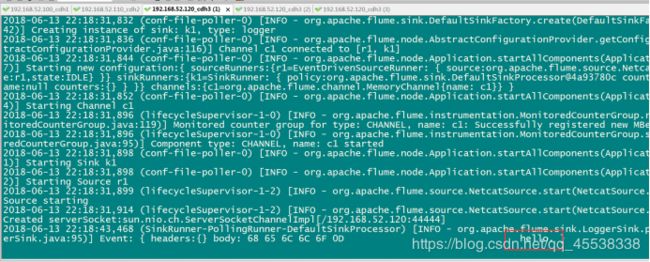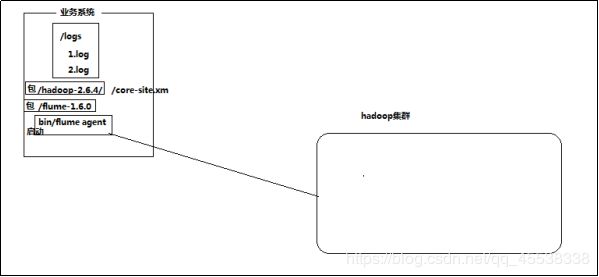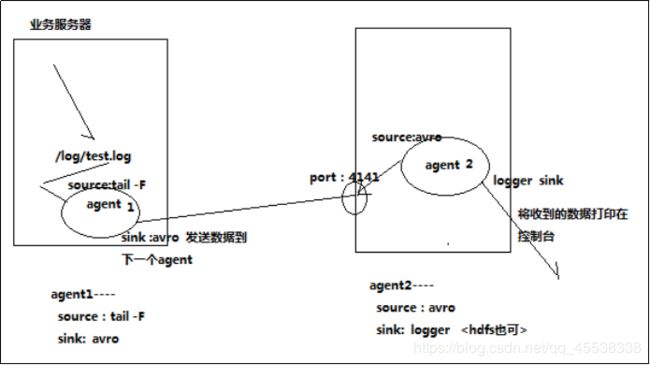Flume基础知识大全
文章目录
- 前言
- 日志采集框架Flume
- 1 Flume介绍
- 1.1 概述
- 1.2 运行机制
- 1.3 Flume采集系统结构图
- 2 Flume实战案例
- 2.1 Flume接受telent数据
- 第一步:开发配置文件
- 第二步:启动配置文件
- 第三步:安装telent准备测试
- 2.2 采集案例
- 1、采集目录到HDFS
- 2、采集文件到HDFS
- 3、两个agent级联
- 3 更多source和sink组件
- 4 高可用Flum-NG配置案例failover
- 4.1、角色分配
- 4.2、node01安装配置flume与拷贝文件脚本
- 4.3、node02与node03配置flumecollection
- 4.4、顺序启动命令
- 4.5、 FAILOVER测试
- 5、flume的负载均衡load balancer
- 第一步:开发node01服务器的flume配置
- 第二步:开发node02服务器的flume配置
- 第三步:开发node03服务器flume配置
- 第四步:准备启动flume服务
- 第五步:node01服务器运行脚本产生数据
- 6、flume过滤器 案例一
- 1. 案例场景
- 2. 场景分析
- 3. 数据流程处理分析
- 4、实现
- 采集端配置文件开发
- 服务端配置文件开发
- 采集端文件生成脚本
- 顺序启动服务
- 5、项目实现截图
前言
在一个完整的离线大数据处理系统中,除了hdfs+mapreduce+hive组成分析系统的核心之外,还需要数据采集、结果数据导出、任务调度等不可或缺的辅助系统,而这些辅助工具在hadoop生态体系中都有便捷的开源框架,如图所示:

日志采集框架Flume
1 Flume介绍
1.1 概述
- Flume是一个分布式、可靠、和高可用的海量日志采集、聚合和传输的系统。
- Flume可以采集文件,socket数据包、文件、文件夹、kafka等各种形式源数据,又可以将采集到的数据(下沉sink)输出到HDFS、hbase、hive、kafka等众多外部存储系统中。
- 一般的采集需求,通过对flume的简单配置即可实现。
- Flume针对特殊场景也具备良好的自定义扩展能力, 因此,flume可以适用于大部分的日常数据采集场景。
宏观角度来看类似生活中的扫码枪、吸尘器吸头。
1.2 运行机制
1、Flume分布式系统中最核心的角色是agent,flume采集系统就是由一个个agent所连接起来形成
2、每一个agent相当于一个数据传递员,内部有三个组件:
- Source:采集组件,用于跟数据源对接,以获取数据
- Channel:传输通道组件,用于从source将数据传递到sink
- Sink:下沉组件,用于往下一级agent传递数据或者往最终存储系统传递数据
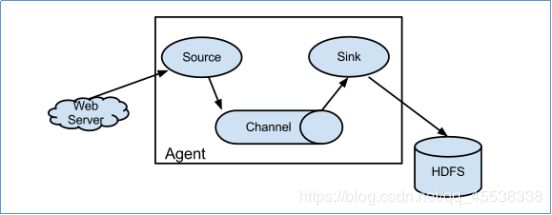
Source 到 Channel 到 Sink之间传递数据的形式是Event事件;Event事件是一个数据流单元。
1.3 Flume采集系统结构图
1. 简单结构
单个agent采集数据
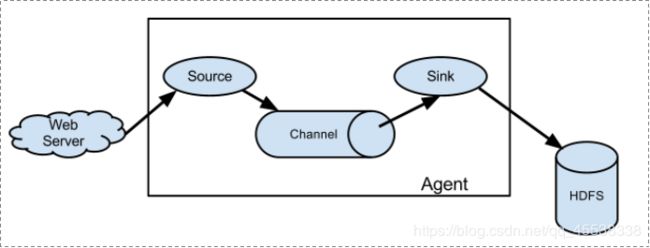
2. 复杂结构
多级agent之间串联
Flume安装部署
Flume的安装非常简单,只需要解压即可,当然,前提是已有hadoop环境
上传安装包到数据源所在节点上
这里我们采用在第三台机器来进行安装
上传安装文件并解压
tar -zxvf flume-ng-1.6.0-cdh5.14.0.tar.gz -C /export/servers/
cd /export/servers/apache-flume-1.6.0-cdh5.14.0-bin/conf
cp flume-env.sh.template flume-env.sh
vim flume-env.sh
export JAVA_HOME=/export/servers/jdk1.8.0_141
2 Flume实战案例
2.1 Flume接受telent数据
案例:使用网络telent命令向一台机器发送一些网络数据,然后通过flume采集网络端口数据

第一步:开发配置文件
根据数据采集的需求配置采集方案,描述在配置文件中(文件名可任意自定义)
配置我们的网络收集的配置文件
在flume的conf目录下新建一个配置文件(采集方案)
vim /export/servers/apache-flume-1.6.0-cdh5.14.0-bin/conf/netcat-logger.conf
# 定义这个agent中各组件的名字
a1.sources = r1
a1.sinks = k1
a1.channels = c1
# 描述和配置source组件:r1
a1.sources.r1.type = netcat
a1.sources.r1.bind = 192.168.52.120
a1.sources.r1.port = 44444
# 描述和配置sink组件:k1
a1.sinks.k1.type = logger
# 描述和配置channel组件,此处使用是内存缓存的方式
a1.channels.c1.type = memory
a1.channels.c1.capacity = 1000
a1.channels.c1.transactionCapacity = 100
# 描述和配置source channel sink之间的连接关系
a1.sources.r1.channels = c1
a1.sinks.k1.channel = c1
Channel参数解释:
capacity: 默认该通道中最大的可以存储的event数量
trasactionCapacity: 每次最大可以从source中拿到或者送到sink中的event数量
第二步:启动配置文件
指定采集方案配置文件,在相应的节点上启动flume agent
先用一个最简单的例子来测试一下程序环境是否正常
启动agent去采集数据
bin/flume-ng agent -c conf -f conf/netcat-logger.conf -n a1 -Dflume.root.logger=INFO,console
-c conf 指定flume自身的配置文件所在目录
-f conf/netcat-logger.con 指定我们所描述的采集方案
-n a1 指定我们这个agent的名字
第三步:安装telent准备测试
在node02机器上面安装telnet客户端,用于模拟数据的发送
yum -y install telnet
telnet node03 44444 # 使用telnet模拟数据发送
2.2 采集案例
1、采集目录到HDFS
采集需求: 某服务器的某特定目录下,会不断产生新的文件,每当有新文件出现,就需要把文件采集到HDFS中去
根据需求,首先定义以下3大要素
- 数据源组件,即source ——监控文件目录 : spooldir
spooldir特性:- 监视一个目录,只要目录中出现新文件,就会采集文件中的内容
- 采集完成的文件,会被agent自动添加一个后缀:COMPLETED
- 所监视的目录中不允许重复出现相同文件名的文件
- 下沉组件,即sink——HDFS文件系统 : hdfs sink
- 通道组件,即channel——可用file channel 也可以用内存channel
flume配置文件开发
配置文件编写:
cd /export/servers/apache-flume-1.6.0-cdh5.14.0-bin/conf
mkdir -p /export/servers/dirfile
vim spooldir.conf
# Name the components on this agent
a1.sources=r1
a1.channels=c1
a1.sinks=k1
# Describe/configure the source
##注意:不能往监控目中重复丢同名文件
a1.sources.r1.type=spooldir
a1.sources.r1.spoolDir=/export/dir
a1.sources.r1.fileHeader = true
# Describe the sink
a1.sinks.k1.type=hdfs
a1.sinks.k1.hdfs.path=hdfs://node01:8020/spooldir/
# Describe the channel
a1.channels.c1.type=memory
a1.channels.c1.capacity=1000
a1.channels.c1.transactionCapacity=100
# Bind the source and sink to the channel
a1.sources.r1.channels=c1
a1.sinks.k1.channel=c1
启动flume
bin/flume-ng agent -c ./conf -f ./conf/spooldir.conf -n a1 -Dflume.root.logger=INFO,console
上传文件到指定目录
将不同的文件上传到下面目录里面去,注意文件不能重名
cd /export/dir
2、采集文件到HDFS
需求分析:
采集需求:比如业务系统使用log4j生成的日志,日志内容不断增加,需要把追加到日志文件中的数据实时采集到hdfs
根据需求,首先定义以下3大要素
- 采集源,即source——监控文件内容更新 : exec ‘tail -F file’
- 下沉目标,即sink——HDFS文件系统 : hdfs sink
- Source和sink之间的传递通道——channel,可用file channel 也可以用 内存channel
定义flume的配置文件
node03开发配置文件
cd /export/servers/apache-flume-1.6.0-cdh5.14.0-bin/conf
vim tail-file.conf
配置文件内容
a1.sources=r1
a1.channels=c1
a1.sinks=k1
# Describe/configure tail -F source1
a1.sources.r1.type=exec
a1.sources.r1.command =tail -F /export/taillogs/access_log
# Describe sink1
a1.sinks.k1.type=hdfs
a1.sinks.k1.hdfs.path=hdfs://node01:8020/spooldir/
# Use a channel which buffers events in memory
a1.channels.c1.type=memory
a1.channels.c1.capacity=1000
a1.channels.c1.transactionCapacity=100
# Bind the source and sink to the channel
a1.sources.r1.channels=c1
a1.sinks.k1.channel=c1
启动flume
cd /export/servers/apache-flume-1.6.0-cdh5.14.0-bin
bin/flume-ng agent -c conf -f conf/tail-file.conf -n agent1 -Dflume.root.logger=INFO,console
开发shell脚本定时追加文件内容
mkdir -p /export/shells/
cd /export/shells/
vim tail-file.sh
#!/bin/bash
while true
do
date >> /export/servers/taillogs/access_log;
sleep 0.5;
done
创建文件夹
mkdir -p /export/servers/taillogs
启动脚本
sh /export/shells/tail-file.sh
3、两个agent级联
需求分析:
第一个agent负责收集文件当中的数据,通过网络发送到第二个agent当中去,第二个agent负责接收第一个agent发送的数据,并将数据保存到hdfs上面去
第一步:node02安装flume
将node03机器上面解压后的flume文件夹拷贝到node02机器上面去
cd /export/servers
scp -r apache-flume-1.6.0-cdh5.14.0-bin/ node02:$PWD
第二步:node02配置flume配置文件
在node02机器配置我们的flume
cd /export/servers/apache-flume-1.6.0-cdh5.14.0-bin/conf
vim tail-avro-avro-logger.conf
##################
# Name the components on this agent
a1.sources = r1
a1.sinks = k1
a1.channels = c1
# Describe/configure the source
a1.sources.r1.type = exec
a1.sources.r1.command = tail -F /export/taillogs/access_log
# Use a channel which buffers events in memory
a1.channels.c1.type = memory
a1.channels.c1.capacity = 1000
a1.channels.c1.transactionCapacity = 100
##sink端的avro是一个数据发送者
a1.sinks.k1.type = avro
a1.sinks.k1.hostname = 192.168.52.120
a1.sinks.k1.port = 4141
#Bind the source and sink to the channel
a1.sources.r1.channels = c1
a1.sinks.k1.channel = c1
第三步:node02开发定脚本文件往写入数据
直接将node03下面的脚本和数据拷贝到node02即可,node03机器上执行以下命令
cd /export
scp -r shells/ taillogs/ node02:$PWD
第五步:node03开发flume配置文件
在node03机器上开发flume的配置文件
cd /export/servers/apache-flume-1.6.0-cdh5.14.0-bin/conf
vim avro-hdfs.conf
# Name the components on this agent
a1.sources = r1
a1.sinks = k1
a1.channels = c1
##source中的avro组件是一个接收者服务
a1.sources.r1.type = avro
a1.sources.r1.bind = 192.168.52.120
a1.sources.r1.port = 4141
# Use a channel which buffers events in memory
a1.channels.c1.type = memory
a1.channels.c1.capacity = 1000
a1.channels.c1.transactionCapacity = 100
# Describe the sink
a1.sinks.k1.type = hdfs
a1.sinks.k1.hdfs.path = hdfs://node01:8020/avro
# Bind the source and sink to the channel
a1.sources.r1.channels = c1
a1.sinks.k1.channel = c1
第六步:顺序启动
node03机器启动flume进程
cd /export/servers/apache-flume-1.6.0-cdh5.14.0-bin
bin/flume-ng agent -c conf -f tmpconf/avro-hdfs.conf -n a1 -Dflume.root.logger=INFO,console
node02机器启动flume进程
cd /export/servers/apache-flume-1.6.0-cdh5.14.0-bin/
bin/flume-ng agent -c conf -f tmpconf/tail-avro-avro-logger.conf -n a1 -Dflume.root.logger=INFO,console
node02机器启shell脚本生成文件
mkdir /export/taillogs/
cd /export/servers/shells
sh tail-file.sh
3 更多source和sink组件
Flume支持众多的source和sink类型,详细手册可参考官方文档
http://archive.cloudera.com/cdh5/cdh/5/flume-ng-1.6.0-cdh5.14.0/FlumeUserGuide.html
4 高可用Flum-NG配置案例failover
在完成单点的Flume NG搭建后,下面我们搭建一个高可用的Flume NG集群,架构图如下所示:
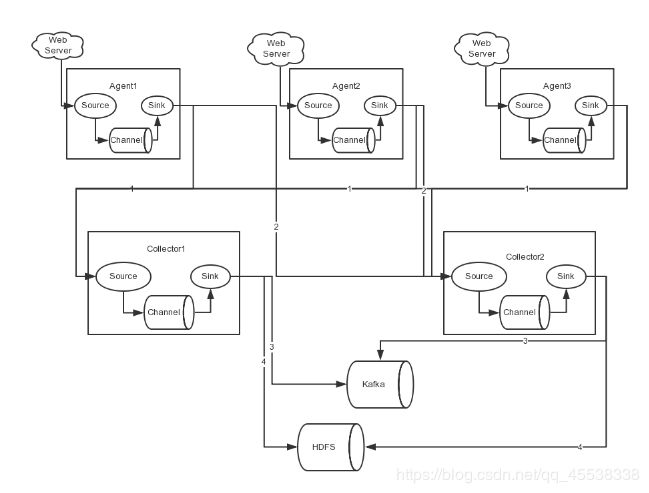
图中,我们可以看出,Flume的存储可以支持多种,这里只列举了HDFS和Kafka(如:存储最新的一周日志,并给Storm系统提供实时日志流)。
4.1、角色分配
Flume的Agent和Collector分布如下表所示:
| 名称 | HOST | 角色 |
|---|---|---|
| Agent1 | node01 | Web Server |
| Collector1 | node02 | AgentMstr1 |
| Collector2 | node03 | AgentMstr2 |
图中所示,Agent1数据分别流入到Collector1和Collector2,Flume NG本身提供了Failover机制,可以自动切换和恢复。在上图中,有3个产生日志服务器分布在不同的机房,要把所有的日志都收集到一个集群中存储。下 面我们开发配置Flume NG集群
4.2、node01安装配置flume与拷贝文件脚本
将node03机器上面的flume安装包以及文件生产的两个目录拷贝到node01机器上面去
node03机器执行以下命令
cd /export/servers
scp -r apache-flume-1.6.0-cdh5.14.0-bin/ node01:$PWD
cd /export
scp -r shells/ taillogs/ node01:$PWD
node01机器配置agent的配置文件
cd /export/servers/apache-flume-1.6.0-cdh5.14.0-bin/conf
vim agent.conf
#agent1 name
agent1.channels = c1
agent1.sources = r1
agent1.sinks = k1 k2
#
##set gruop
agent1.sinkgroups = g1
##set sink group
agent1.sinkgroups.g1.sinks = k1 k2
#
agent1.sources.r1.type = exec
agent1.sources.r1.command = tail -F /export/taillogs/access_log
#
##set channel
agent1.channels.c1.type = memory
agent1.channels.c1.capacity = 1000
agent1.channels.c1.transactionCapacity = 100
## set sink1
agent1.sinks.k1.type = avro
agent1.sinks.k1.hostname = node02
agent1.sinks.k1.port = 52020
#
## set sink2
agent1.sinks.k2.type = avro
agent1.sinks.k2.hostname = node03
agent1.sinks.k2.port = 52020
#
##set failover
agent1.sinkgroups.g1.processor.type = failover
agent1.sinkgroups.g1.processor.priority.k1 = 2
agent1.sinkgroups.g1.processor.priority.k2 = 1
agent1.sinkgroups.g1.processor.maxpenalty = 10000
#
agent1.sources.r1.channels = c1
agent1.sinks.k1.channel = c1
agent1.sinks.k2.channel = c1
maxpenalty故障转移的默认时间
4.3、node02与node03配置flumecollection
node02机器修改配置文件
cd /export/servers/apache-flume-1.6.0-cdh5.14.0-bin/conf
vim collector.conf
#set Agent name
a1.sources = r1
a1.channels = c1
a1.sinks = k1
## other node,nna to nns
a1.sources.r1.type = avro
a1.sources.r1.bind = node02
a1.sources.r1.port = 52020
##set channel
a1.channels.c1.type = memory
a1.channels.c1.capacity = 1000
a1.channels.c1.transactionCapacity = 100
#
##set sink to hdfs
a1.sinks.k1.type=hdfs
a1.sinks.k1.hdfs.path= hdfs://node01:8020/flume/failover/
a1.sources.r1.channels=c1
a1.sinks.k1.channel=c1
node03机器修改配置文件
cd /export/servers/apache-flume-1.6.0-cdh5.14.0-bin/conf
vim collector.conf
#set Agent name
a1.sources = r1
a1.channels = c1
a1.sinks = k1
## other node,nna to nns
a1.sources.r1.type = avro
a1.sources.r1.bind = node03
a1.sources.r1.port = 52020
##set channel
a1.channels.c1.type = memory
a1.channels.c1.capacity = 1000
a1.channels.c1.transactionCapacity = 100
#
##set sink to hdfs
a1.sinks.k1.type=hdfs
a1.sinks.k1.hdfs.path= hdfs://node01:8020/flume/failover/
a1.sources.r1.channels=c1
a1.sinks.k1.channel=c1
4.4、顺序启动命令
node03机器上面启动flume
cd /export/servers/apache-flume-1.6.0-cdh5.14.0-bin
bin/flume-ng agent -n a1 -c conf -f tmpconf/collector.conf -Dflume.root.logger=DEBUG,console
node02机器上面启动flume
cd /export/servers/apache-flume-1.6.0-cdh5.14.0-bin
bin/flume-ng agent -n a1 -c conf -f tmpconf/collector.conf -Dflume.root.logger=DEBUG,console
node01机器上面启动flume
cd /export/servers/apache-flume-1.6.0-cdh5.14.0-bin
bin/flume-ng agent -n agent1 -c conf -f conf/agent.conf -Dflume.root.logger=DEBUG,console
node01机器启动文件产生脚本
cd /export/shells
sh tail-file.sh
4.5、 FAILOVER测试
下面我们来测试下Flume NG集群的高可用(故障转移)。场景如下:我们在Agent1节点上传文件,由于我们配置Collector1的权重比Collector2大,所以 Collector1优先采集并上传到存储系统。然后我们kill掉Collector1,此时有Collector2负责日志的采集上传工作,之后,我 们手动恢复Collector1节点的Flume服务,再次在Agent1上次文件,发现Collector1恢复优先级别的采集工作。具体截图如下所 示:
HDFS集群中上传的log内容预览

Collector1宕机,Collector2获取优先上传权限

重启Collector1服务,Collector1重新获得优先上传的权限
5、flume的负载均衡load balancer
负载均衡是用于解决一台机器(一个进程)无法解决所有请求而产生的一种算法。Load balancing Sink Processor 能够实现 load balance 功能,如下图Agent1 是一个路由节点,负责将 Channel 暂存的 Event 均衡到对应的多个 Sink组件上,而每个 Sink 组件分别连接到一个独立的 Agent 上,示例配置,如下所示:

在此处我们通过三台机器来进行模拟flume的负载均衡
三台机器规划如下:
node01: 采集数据,发送到node02和node03机器上去
node02: 接收node01的部分数据
node03: 接收node01的部分数据
第一步:开发node01服务器的flume配置
node01服务器配置:
cd /export/servers/apache-flume-1.6.0-cdh5.14.0-bin/conf
vim load_banlancer_client.conf
#agent name
a1.channels = c1
a1.sources = r1
a1.sinks = k1 k2
#set gruop
a1.sinkgroups = g1
#set sink group
a1.sinkgroups.g1.sinks = k1 k2
#set sources
a1.sources.r1.type = exec
a1.sources.r1.command = tail -F /export/taillogs/access_log
#set channel
a1.channels.c1.type = memory
a1.channels.c1.capacity = 1000
a1.channels.c1.transactionCapacity = 100
# set sink1
a1.sinks.k1.type = avro
a1.sinks.k1.hostname = node02
a1.sinks.k1.port = 52021
# set sink2
a1.sinks.k2.type = avro
a1.sinks.k2.hostname = node03
a1.sinks.k2.port = 52021
#set failover
a1.sinkgroups.g1.processor.type = load_balance
a1.sinkgroups.g1.processor.backoff = true
a1.sinkgroups.g1.processor.selector = round_robin
a1.sinkgroups.g1.processor.selector.maxTimeOut=10000
a1.sources.r1.channels = c1
a1.sinks.k1.channel = c1
a1.sinks.k2.channel = c1
第二步:开发node02服务器的flume配置
cd /export/servers/apache-flume-1.6.0-cdh5.14.0-bin/conf
vim load_banlancer_server.conf
# Name the components on this agent
a1.sources = r1
a1.sinks = k1
a1.channels = c1
# Describe/configure the source
a1.sources.r1.type = avro
a1.sources.r1.bind = node02
a1.sources.r1.port = 52021
# Use a channel which buffers events in memory
a1.channels.c1.type = memory
a1.channels.c1.capacity = 1000
a1.channels.c1.transactionCapacity = 100
# Describe the sink
a1.sinks.k1.type = logger
# Bind the source and sink to the channel
a1.sources.r1.channels = c1
a1.sinks.k1.channel = c1
第三步:开发node03服务器flume配置
node03服务器配置
cd /export/servers/apache-flume-1.6.0-cdh5.14.0-bin/conf
vim load_banlancer_server.conf
# Name the components on this agent
a1.sources = r1
a1.sinks = k1
a1.channels = c1
# Describe/configure the source
a1.sources.r1.type = avro
a1.sources.r1.bind = node03
a1.sources.r1.port = 52021
# Use a channel which buffers events in memory
a1.channels.c1.type = memory
a1.channels.c1.capacity = 1000
a1.channels.c1.transactionCapacity = 100
# Describe the sink
a1.sinks.k1.type = logger
# Bind the source and sink to the channel
a1.sources.r1.channels = c1
a1.sinks.k1.channel = c1
第四步:准备启动flume服务
启动node03的flume服务
cd /export/servers/apache-flume-1.6.0-cdh5.14.0-bin
bin/flume-ng agent -n a1 -c conf -f conf/load_banlancer_server.conf -Dflume.root.logger=DEBUG,console
启动node02的flume服务
cd /export/servers/apache-flume-1.6.0-cdh5.14.0-bin
bin/flume-ng agent -n a1 -c conf -f conf/load_banlancer_server.conf -Dflume.root.logger=DEBUG,console
启动node01的flume服务
cd /export/servers/apache-flume-1.6.0-cdh5.14.0-bin
bin/flume-ng agent -n a1 -c conf -f conf/load_banlancer_client.conf -Dflume.root.logger=DEBUG,console
第五步:node01服务器运行脚本产生数据
cd /export/shells
sh tail-file.sh
6、flume过滤器 案例一
1. 案例场景
A、B两台日志服务机器实时生产日志主要类型为access.log、nginx.log、web.log
现在要求:
把A、B 机器中的access.log、nginx.log、web.log 采集汇总到C机器上然后统一收集到hdfs中。
但是在hdfs中要求的目录为:
/source/logs/access/20180101/**
/source/logs/nginx/20180101/**
/source/logs/web/20180101/**
2. 场景分析
3. 数据流程处理分析
4、实现
服务器A对应的IP为 192.168.52.100
服务器B对应的IP为 192.168.52.110
服务器C对应的IP为 192.168.52.120
采集端配置文件开发
node01与node02服务器开发flume的配置文件
cd /export/servers/apache-flume-1.6.0-cdh5.14.0-bin/conf
vim exec_source_avro_sink.conf
# Name the components on this agent
a1.sources = r1 r2 r3
a1.sinks = k1
a1.channels = c1
# Describe/configure the source
a1.sources.r1.type = exec
a1.sources.r1.command = tail -F /export/taillogs/access.log
a1.sources.r1.interceptors = i1
a1.sources.r1.interceptors.i1.type = static
## static拦截器的功能就是往采集到的数据的header中插入自己定## 义的key-value对
a1.sources.r1.interceptors.i1.key = type
a1.sources.r1.interceptors.i1.value = access
a1.sources.r2.type = exec
a1.sources.r2.command = tail -F /export/taillogs/nginx.log
a1.sources.r2.interceptors = i2
a1.sources.r2.interceptors.i2.type = static
a1.sources.r2.interceptors.i2.key = type
a1.sources.r2.interceptors.i2.value = nginx
a1.sources.r3.type = exec
a1.sources.r3.command = tail -F /export/taillogs/web.log
a1.sources.r3.interceptors = i3
a1.sources.r3.interceptors.i3.type = static
a1.sources.r3.interceptors.i3.key = type
a1.sources.r3.interceptors.i3.value = web
# Use a channel which buffers events in memory
a1.channels.c1.type = memory
a1.channels.c1.capacity = 20000
a1.channels.c1.transactionCapacity = 10000
# Describe the sink
a1.sinks.k1.type = avro
a1.sinks.k1.hostname = node03
a1.sinks.k1.port = 41414
# Bind the source and sink to the channel
a1.sources.r1.channels = c1
a1.sources.r2.channels = c1
a1.sources.r3.channels = c1
a1.sinks.k1.channel = c1
注:
a1.sources.r1.interceptors = i1
a1.sources.r1.interceptors.i1.type = static
## static拦截器的功能就是往采集到的数据的header中插入自己定## 义的key-value对
a1.sources.r1.interceptors.i1.key = type
a1.sources.r1.interceptors.i1.value = access
服务端配置文件开发
在node03上面开发flume配置文件
cd /export/servers/apache-flume-1.6.0-cdh5.14.0-bin/conf
vim avro_source_hdfs_sink.conf
a1.sources = r1
a1.sinks = k1
a1.channels = c1
#定义source
a1.sources.r1.type = avro
a1.sources.r1.bind = 192.168.52.120
a1.sources.r1.port =41414
#添加时间拦截器
a1.sources.r1.interceptors = i1
a1.sources.r1.interceptors.i1.type = org.apache.flume.interceptor.TimestampInterceptor$Builder
#定义channels
a1.channels.c1.type = memory
a1.channels.c1.capacity = 20000
a1.channels.c1.transactionCapacity = 10000
#定义sink
a1.sinks.k1.type = hdfs
a1.sinks.k1.hdfs.path=hdfs://192.168.52.100:8020/source/logs/%{type}/%Y%m%d
#组装source、channel、sink
a1.sources.r1.channels = c1
a1.sinks.k1.channel = c1
采集端文件生成脚本
在node01与node02上面开发shell脚本,模拟数据生成
cd /export/servers/shells
vim server.sh
#!/bin/bash
while true
do
date >> /export/servers/taillogs/access.log;
date >> /export/servers/taillogs/web.log;
date >> /export/servers/taillogs/nginx.log;
sleep 0.5;
done
顺序启动服务
node03启动flume实现数据收集
cd /export/servers/apache-flume-1.6.0-cdh5.14.0-bin
bin/flume-ng agent -c conf -f conf/avro_source_hdfs_sink.conf -name a1 -Dflume.root.logger=DEBUG,console
node01与node02启动flume实现数据监控
cd /export/servers/apache-flume-1.6.0-cdh5.14.0-bin
bin/flume-ng agent -c conf -f conf/exec_source_avro_sink.conf -name a1 -Dflume.root.logger=DEBUG,console
node01与node02启动生成文件脚本
cd /export/shells
sh server.sh
